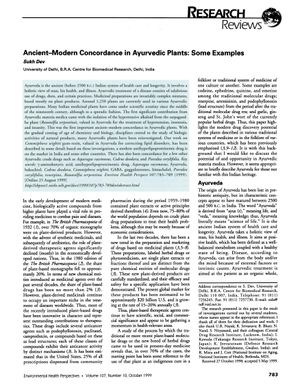Ancient-modern concordance in Ayurvedic plants: some examples.
October 1999
in “Environmental Health Perspectives”

TLDR Modern science supports the use of some Ayurvedic plants for health, as ancient practices suggested.
The document from 1999 examines the alignment between ancient Ayurvedic practices and modern scientific research, particularly in the medicinal use of plants. It presents several Ayurvedic plants whose traditional uses have been substantiated by contemporary scientific studies. For instance, Rauwolfia serpentina, used for hypertension and mental disorders, contains reserpine, which is effective in managing blood pressure and has tranquilizing properties. Asparagus racemosus, known for its lactation benefits, has compounds that inhibit uterine contractions. Cedrus deodara has been validated for its dermatological applications, and Commiphora wightti has yielded compounds effective in lipid reduction. The document also explores the potential of Ayurvedic plants in promoting hair growth and their broader implications in drug discovery, nutraceuticals, and cosmeceuticals. It underscores the importance of integrating traditional knowledge with modern scientific validation and the need for standardization and clinical evaluation of herbal medicines.
View this study on ehp.niehs.nih.gov →
Related

research Ancient-modern concordance in Ayurvedic plants: some examples.
Modern science supports the use of some Ayurvedic plants for health, as ancient practices suggested.